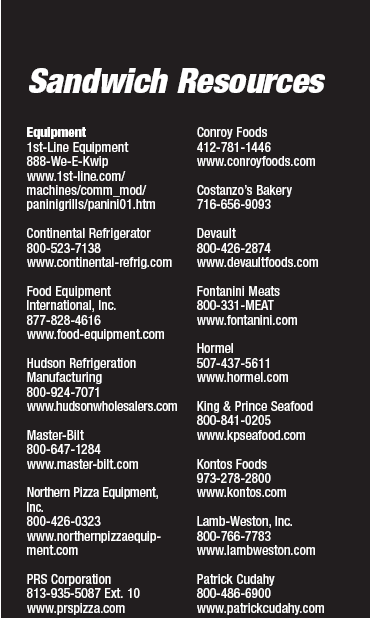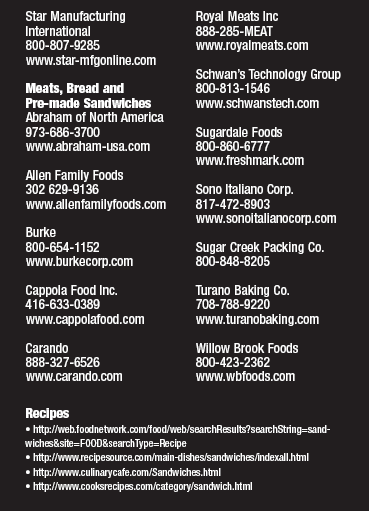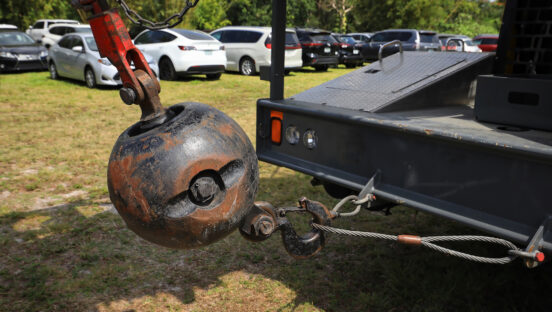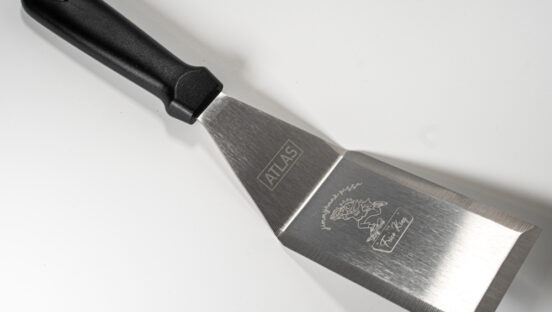Why should you consider adding subs or sandwiches to your menu? Offering more than pizza gives customers another reason to eat at your restaurant more than once a week. Sandwiches are also fast, a staple for lunchtime crowds and one of the best performing categories in the QSR segment.
In the 2003 Technomic Top 100, an analysis of the 100 largest U.S. chain restaurant companies, the sandwich category shows tremendous growth and potential. In the category listing the top growth companies ranked by percentage increase in sales, the number one spot went to Quiznos Corp. and the second spot went to Panera, Inc., both of which focus on sandwiches. Quiznos had an amazing 68.5 percent rise in sales from the previous year and Panera had a 42.7 percent rise in sales from 2001 to 2002. In the category of growth ranked by increase in units, Subway Sandwiches topped the list with 1,275 more units (9.6 percent increase) than the year before and Quiznos came in fourth with a 38.8 percent increase in units, which translated into 503 new locations. This 38.8 percent increase in units for Quiznos gave them the top position in the country in the growth by percentage increase in units category.
The numbers speak for themselves; customers are going for sandwiches. Liz Hurtz with Burke Corp. says that recently they did some research on the top 36 pizza chains and found that sandwich products made up 44 percent of their non-pizza items sold. "The main items we found these companies are buying are deli meats, meatballs and sausage," Liz says.
Prime Time for Sub Sales
Sandwiches are a natural addition for a pizzeria and can be quite easy and beneficial in bringing in customers, especially during lunch. After surveying several pizzeria operators, both single unit and franchise chains, the consensus is that subs and sandwiches sell best during the lunch rush and tend to fall off for the dinner crowds. "About 15 to 20 percent of my total sales are subs," says Rick Bowman, owner of PJ's Pizza and Subs in Mt. Pleasant, Pa. "Most of those sales come at lunch."
Customers can't eat pizza all of the time, and unless you offer them something else, they will go somewhere else. Jim Howell, president of Perky's Pizza, which has 425 locations in the U.S., agrees. "Sandwich sales are best during lunch and tough in the evenings and on the weekends," Jim says. "We added subs and sandwiches about three years ago at the request of our operators. Many wanted to expand their menu without expanding their capital investment. Now, sandwiches are about 10 to 15 percent of our sales."
John Turzer, owner of DeMatteo's Pizza, Pasta and Subs in Riverside, Calif. says subs are not only good for customers that are looking for something quick to go, they are versatile, too. "When the weather is hot, people tend to order more cold subs," John says. "When it is cold, they order more hot sandwiches. Last month, subs equaled 10 percent of our sales."
What's Hot and What's Not
One of the beauties of adding subs or sandwiches is you can make them as upscale or as simple as you like, cold or hot, half or whole and on bread or rolls. One advantage to rolls is you can offer different sizes using the same roll. Most are 12-inch rolls, which you can cut in half for smaller sandwiches. Many operators who already have sandwiches recommend starting out simple with the basic offerings.
"Our biggest seller is the Italian sub," Rick Bowman says. "We use ham, two types of salami, two cheeses and a special sauce for the Italian sub. We also sell a lot of Philly cheese steaks and turkey and bacon with cheddar subs." John Turzer says he also sells a lot turkey subs as well as roast beef. In interviews with operators, it appears the best choices for those starting out are ham and cheese, cheese steak (both beef and chicken), Italian and meatball subs because customers are familiar with the flavor profiles and they sell well.
When serving subs, you have the choice of offering hot or cold sandwiches. For hot subs, simply place the meat and cheese on the rolls and run them through your pizza oven and then dress them with condiments after they come out.
Marketing and Pricing
Subs and sandwiches can stand alone as a meal for some, but many customers want side items to make them a complete meal. The most popular side items are chips, fries and pickle spears. There are three ways to price sides; you can include them with the meal, charge extra for each side item added or create combo meals. "We automatically put chips on the side of each sub that is ordered," John says. "As I said, we sell most of our subs during lunch, but I have found that by offering three subs for $10.99 we were able to sell a few more at night. People are ordering for families at night and for themselves during the day. To market the subs, we send postcards to local businesses with pictures of the sandwiches on them since people on their lunch break are the ones buying them. Start off simple and work out from there because if you have too many sandwiches, you can create a jam when business gets in a rush."
Rick says everything on their menu is a la Carte and side items are sold separately. "We mostly sell fries and onion rings, but we do offer other things like Poppers and cheese sticks," Rick says. "We do some family deals. One is a one-topping large pizza, whole sub and 2-liter pop for $12.70. Our whole sub is 12 inches and sells for $5.09, but we do offer half subs, too. We have learned that for subs, you have to price your items right. You need to make as much on them as you do on your pizza. You want everything on your menu to make money. To control costs, we either have a set number of slices or weigh out the meats for the subs. The subs sell on their own and mainly push pizza with our marketing."
Jim also agrees that you have to use the same logic as pizza and go with your strengths and look at regional tastes to decide what subs to offer. "Pick two or three great sandwiches to start and go from there," he says. "Don't try to compete with Subway and keep it simple in the beginning. We offer combos that include chips, a sub and drink for $4.99 to $5.99 depending on which sub they order. As far as marketing, we use posters, vinyl window stickers and countertop displays to let people know about the subs."
Operations and Equipment
It is quite easy to add subs these days, but some choices must be made before you start. The simplest way is to buy meats pre-sliced, buy the rolls from your distributor or local bakery and keep other items in plastic containers. If you do a lot of lunch or plan to really push the subs, you may want to look into buying meats uncut and slicing them yourself, making your own rolls and investing in a sandwich prep table.
If you only offer three or four subs, prep space isn't a concern and pizza makers can assemble them on the make-line. If you have more sandwiches, there are many different styles of prep tables where lettuce, tomato, meats and rolls can be kept cool and stored. A general rule is if you require a separate person in the sandwich department, you will probably need a sandwich station, but this can also double as a salad and side station, too.
"At first we kept everything in plastic containers," Rick says. "We eventually worked ourselves up to the point where we now have a separate prep table. It really depends on the day as to whether we have a person dedicated to just sandwiches. On slower days, our pizza makers handle it. We have our own slicers, but sometimes buy meats pre-sliced. The difference in our cost is about 20 cents a pound."
Other things to consider when determining what subs you will offer are menu and menu board space, packaging and finding quality products. For to-go orders, there are many different options. You can simply roll sandwiches in paper or order special sandwich containers. The upscale way to go is with the black-bottom, clear top clamshell trays. These containers give sandwiches more of a gourmet appearance, but you can also use Styrofoam containers. Some companies offer elongated boxes specially made for subs.
Why Add Subs?
The best customers are ones who order from you more than once a week. To attract these people, you can't expect them to eat the same thing over and over. Few people bring their lunch to work these days, so variety guides their decisions. With the addition of subs, and possibly salads and pastas, customers can stay close to work and get something different every day. Subs can also be attractive to the health conscious individual looking for a light sandwich option. If adding subs is a consideration, do like those who already sell subs say and start simple. If they sell well, try adding one or two more at a later date. If they don't sell as well, remove or replace them with something different. Make sure you know how much it costs to build the sandwich and price it so it adds to your bottom line. Just remember, customers want choices and judging by the statistics, sandwiches are emerging as their option.
|
Sandwich History The first recorded sandwich was by the famous rabbi, Hillel, who lived during the 1st century B.C. He started the Passover custom of sandwiching a mixture of chopped nuts, apples, spices, and wine between two matzohs to eat with bitter herbs. The filling between the matzohs served as a reminder of the suffering of the Jews before their deliverance from Egypt and represented the mortar used by the Jews in their forced labor of constructing Egyptian buildings. During the Middle Ages (6th to 16th century), thick blocks of bread called trenchers were used in place of plates. Meats and other foods were piled on top of the bread to be eaten. At the end of the meal, one either ate the trencher or, if hunger had been satisfied, tossed the gravy-soaked bread to another less fortunate human or animal. It is also said that the cooks at London's Beef Steak Club, a restaurant, invented the first sandwich. John Montague (1718-1792), the Fourth Earl of Sandwich, usually gambled for hours at a time at this restaurant, sometimes refusing to get up even for meals. It is said that ordered his valet to bring him meat tucked between two pieces of bread. Because Montague also happened to be the Fourth Earl of Sandwich, others began to order "the same as Sandwich!" Today, billions of sandwiches of unbelievable variety are his legacy. -SOURCE: http://www.whatscookingamerica.net/History/SandwichHistory.htm |
|
Submarine, grinder, hero, hoagie, Italian sandwich, poor boy, sub, torpedo All these terms are regional variants for the name of a popular sandwich made by splitting a long, torpedo-shaped roll in half lengthwise and filling it with some or all of these: cold cuts, sausage, cheese, lettuce, tomato, pickles, and other condiments. The chief interest here is that there is no apparent generic name for this sandwich – in fact, many major cities have their own names for it. Subs America Eats Out, John Mariani [Morrow:New York] 1991 (p. 114-5) Hero Encyclopedia of American Food and Drink, John F. Mariani [Lebhar-Friedman:New York] 1999 (p. 154) Po'Boy Encyclopedia of American Food and Drink, John F. Mariani [Lebhar-Friedman:New York] 1999 (p. 246) Philadelphia Cheese Steak Encyclopedia of American Food and Drink, John F. Mariani [Lebhar-Friedman:New York] 1999 (p. 238) Chicago Italian beef sandwiches "Italian beef stand. An inexpensive restaurant or streetside stand selling sliced beef in a spicy gravy. Italian beef is a specialty of the Midwest, especially Chicago. The name merely refers to some vague idea of how Italians would serve their beef- highly seasoned – but there is no such dish in Italy." Encyclopedia of American Food and Drink (p. 168) Grinder |
|
Sub Roll Formula and Procedure These rolls can be used for making typical sub-rolls, hoagies, or grinders. Additionally, they can be used for making a multitude of open-face, hot sandwiches. FORMULA: Flour (strong bread flour) 100.00% 25 lbs PROCEDURE: Adjust water temperature to approximately 70˚F and add to the mixing bowl. Add the flour and all of the remaining ingredients. Using a dough hook, mix at low speed for four minutes, then at medium speed for about 15 minutes, or until the dough is smooth and fairly well developed. Target dough temperature is 80˚F. After mixing, scale the dough into 3.5 ounce pieces and form into balls, allow the dough balls to rest on a floured bench top for 20 to 30 minutes, then roll out to form a thin sheet about 1/4 inch thick. Roll the sheeted dough piece (jelly roll fashion) to form a small loaf about seven inches long. Place each formed loaf/roll onto a lightly oiled sheet pan with the seam side down to prevent the dough from becoming unwrapped during proofing. Be sure to separate the individual dough pieces by about two inches to prevent them from baking together Place the formed dough pieces into a proof box at 100˚F and 75 percent relative humidity, and allow to proof for 45 to 60 minutes. Using a razor blade, make a slit along the entire top of each roll about 3/16 to 1/4 inch deep, lightly mist the rolls with water and bake at 425˚F for about 20 minutes, or until the rolls are lightly browned. Remove the rolls from the pans soon after baking and allow to cool on wire screens or racks. As soon as the rolls have cooled to an internal temperature of 100˚F they can be placed into cardboard boxes lined with an approved, polyethylene bag and sealed closed for storage. The rolls can be kept for three to four days at room temperature. |
|
PIZZA SANDWICHES Not everyone wants to or has the space or capabilities to add sandwiches to their menus, but options are out there. PMQ spoke with Pizza Paul Nyland at the Mid-America Pizza Show (now known as the North American Pizza and Ice Cream Show, or NAPICS) and he offers some interesting adaptations to pizza in the form of sandwich pizzas. "I have noticed in the fast food industry that many sandwich and burger guys are getting into pizza," Pizza Paul said. "Why not have the pizza industry get into sandwiches? One of the more popular pizzas here at the show is a gourmet cheeseburger pizza. It is a cheeseburger with a different format. You use the same dough as your pizzas and add a pre-cooked hamburger topping, cheddar and Jack cheeses, which gives it a gourmet look and taste, and then add your condiments. You can add onions, mayo, ketchup, mustard or any other item you would put on a burger. "The dough, which substitutes the bun, is fresh and gives the customer less bread and fewer carbohydrates. I have one customer who sells a ton of these pizzas. They can also be offered in any size you want, which is great for lunch. Not only can you offer cheeseburger pizzas, but I have recipes for a BLT pizza, a Reuben pizza and a club pizza. For the club pizza, simply take the BLT and add ham and turkey." Pizza Paul worked for GFS for 32 years, the last 13 of which he specifically worked with the pizza industry and Big Dave Ostrander. His primary focus was in operations. When it comes to adding gourmet pizzas, he says ones like the sandwich-style pizzas mentioned here are appealing and versatile, but warns that just adding them to the menu isn't going to create immediate sales. "Places like California Pizza Kitchen and some others have made upscale and gourmet pizzas very popular," Pizza Paul says. "I suggest operators add four or five specialty pizza, but remember it takes a different marketing approach. You have to let people know they are on the menu and let them sample the new additions. Only after they are aware of them and have tried them will their sales and popularity start to grow." "Pizza" Paul Recipies The Ever Popular BLT Pizza 14"- Crust/Dough-Brush with Olive Oil Suggestion: I like to use a disposable pastry bag to apply the mayo. One bag will hold about 1/2 gal of mayo. The Dyno-Club Pizza Follow the above recipe and add 5 oz of Ham and Turkey each. The Reuben Pizza 14" Crust/Dough The Gourmet Cheeseburger or The Gourmet Cheeseburger Deluxe (Add lettuce and tomato) 14" Crust/Dough
***** It is important that the ground beef you use has some texture to it after it is cooked. We do not want a Sloppy Joe or a Taco Meat texture. This can be accomplished two ways. Some food service distributors stock an IQF (Individually Quick Frozen) ground beef. This is ground beef that is frozen in strands as it exits the grinder. A 1/4" grind gives a nice texture. This product should be spread on a baking pan and baked off to maintain it's shape and texture. The next method would be to spread fresh ground beef on the baking pan and bake it off as one big patty. After cooking and draining you can then chop the cooked beef to a size that will still tell the consumer he is biting into a piece of meat. All of the Sandwich Style Pizza's are great served as an individule 6" or 7" Pizza for lunch. When studying the statistics for this article, we discovered that some of the hottest concepts in the restaurant industry are sandwich concepts. The numbers speak for themselves. If adding a sandwich station isn't an option, maybe sandwich pizzas are something you can add. For recipes on the sandwich pizzas mentioned in this article, be sure to check out the PMQ Recipe Bank on the PMQ Recipe Bank. |















